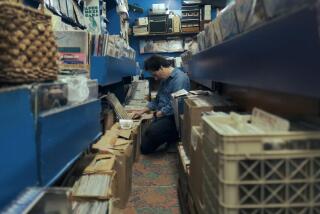BOOK REVIEW / BIOGRAPHY : Inventing a Future Where None Existed : STREISAND, by James Spada (Crown Publishers; $25, 560 pages)
- Share via
Once upon a time there was a little girl with a big voice and a small future: Barbra Streisand’s father died when she was 2 1/2, and for many years she seemed doomed to a life of anonymous poverty, opportunity always just a half-step ahead. Her mother, Diana, resisted her daughter’s interest in an acting career, and her stepfather, Louis Kind, dismissed wholesale his role as provider and supportive dad.
The only thing was, Barbara (she removed the second “a” later) could not stand that life, and refused to settle for it. Perhaps the most engrossing aspect of James Spada’s “Streisand” is the story of how Streisand invented a future for herself where none existed.
She thought at first of being an actress, not a singer, and if that required lying about her age to qualify for a workshop, so be it. She was prepared to do anything to escape--and Spada does a wonderful job of re-creating the scenes of her youth, as she scrambled to make a name for herself.
He also captures her rather wacky lack of preparation for life as a premature grown-up. The description of the first apartment she shared with actor and then-husband Elliott Gould is a comic fantasy of how artsy types ought to live, right down to the TV dinners on her sewing machine table and the cot that served as a double bed. She careened into her new life--insecure and determined, that insecurity the foundation of a demanding nature.
Spada chronicles Streisand’s rise from rags to riches, and then on to full-tilt legend: Her early acting escapades, her first singing gig in a gay club, her often-clumsy transition into the mainstream, and then, what can only be called the stardom era, in which almost everything she touched, including some less than splendid movies (remember “A Star Is Born”?), turned to gold. All of it, he suggests, a quest for the appreciation she was denied as a child.
And then there are the romances, which kept a goodly number of tabloid reporters employed: After Gould came (and this is not a complete list) hairdresser-cum-Hollywood producer Jon Peters, actor Don Johnson, musician Richard Baskin, and, according to Spada, a couple of attractions that never turned into affairs, including Streisand’s co-star in “The Way We Were,” Robert Redford.
Which is not to say it has been easy. Spada lays out just what it’s like for even a diva of Streisand’s stature to work in the boys’ club known as Hollywood. He embellishes all the headlines--like the time Streisand was denied an Oscar nomination for “Prince of Tides,” although the movie itself won a handful of nominations--and manages to capture both sides of the controversy. The men who handle the money may behave in a less than enlightened manner--but we also get to see Streisand’s well-known, and expensive, penchant for perfectionism.
If there is a problem here (and Streisand fans will forgive it easily) it is that Spada sometimes gets tangled up in his mass of facts. Some portions of the book start to sound less like exposition than like inventory: He introduces Don Johnson as “a self-described hell-raiser as a kid in Missouri who lost his virginity at age 12 to a 17-year-old baby sitter. . . .” A lot of history wrapped up in a single phrase. Sometimes the prose can get a little dense, and the reader has to sit back for a moment and unravel all the information.
And, of course, Streisand herself is missing in action; since she did not cooperate with Spada, he had to rely on previously published interviews with the press-shy entertainer. Again, it won’t matter to the fans who love her. There is plenty of material here to amuse, entertain and even illuminate her carefully guarded life.
More to Read
Sign up for our Book Club newsletter
Get the latest news, events and more from the Los Angeles Times Book Club, and help us get L.A. reading and talking.
You may occasionally receive promotional content from the Los Angeles Times.







